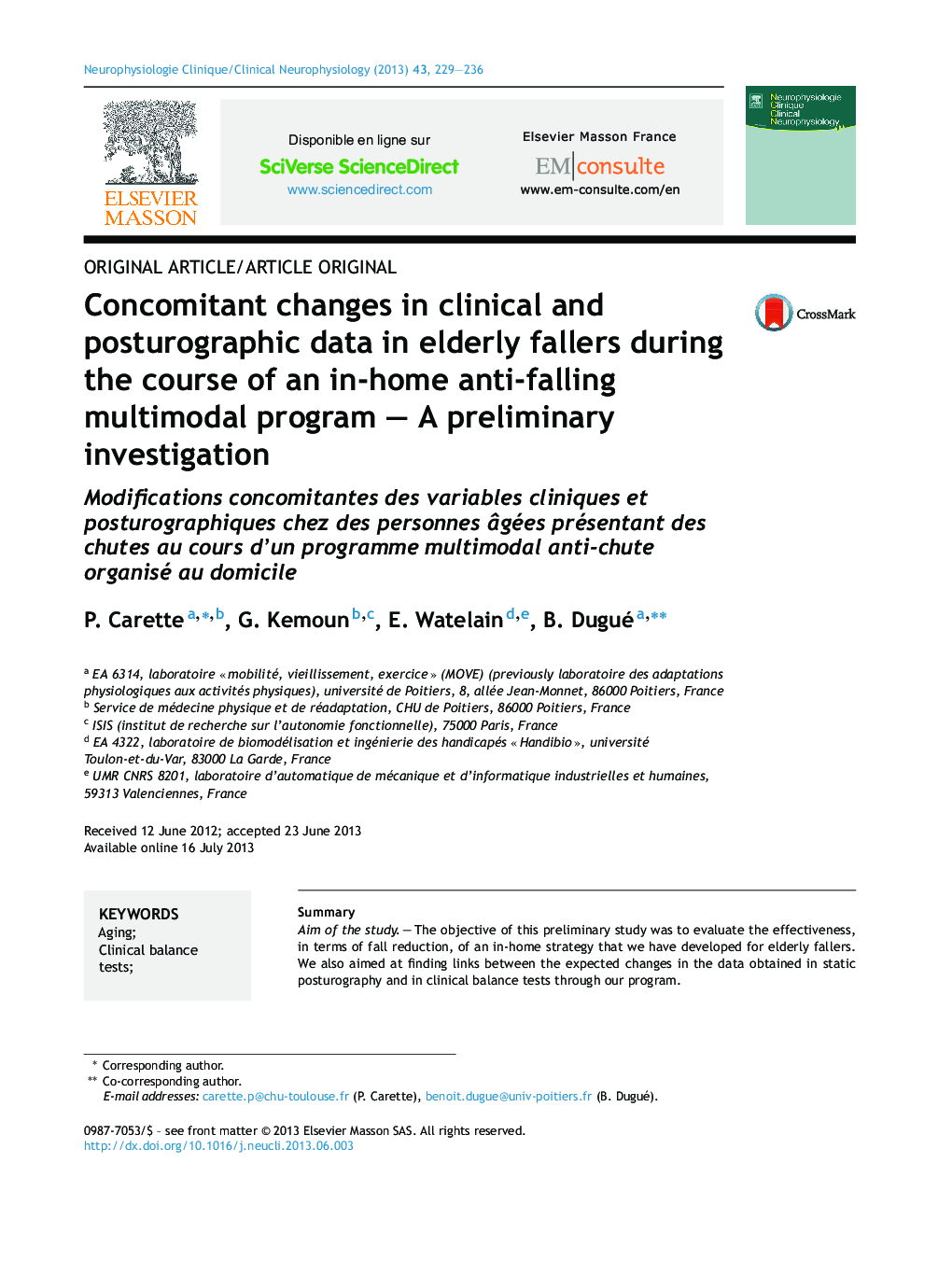| Article ID | Journal | Published Year | Pages | File Type |
|---|---|---|---|---|
| 3082440 | Neurophysiologie Clinique/Clinical Neurophysiology | 2013 | 8 Pages |
SummaryAim of the studyThe objective of this preliminary study was to evaluate the effectiveness, in terms of fall reduction, of an in-home strategy that we have developed for elderly fallers. We also aimed at finding links between the expected changes in the data obtained in static posturography and in clinical balance tests through our program.Patients and methodsTwelve elderly patients living at home who were diagnosed as fallers (5 males and 7 females; 77.9 ± 4.1 years) participated in the study. Our multimodal intervention lasted 6 months. Before this period, and one year later, an evaluation was conducted using cognitive (MMSE), clinical balance tests (i.e. Berg Balance Scale, Balance One leg, Timed Up and Go, and Functional Reach tests) and static posturography (where the area of body sway, velocity and medio–lateral and antero–posterior amplitudes were recorded twice, first with eyes open and then with eyes closed).ResultsAmong the 12 patients who were diagnosed as fallers, eight became non-fallers. When comparing data obtained after the intervention with those obtained beforehand, we found significant changes in all of the clinical balance tests and in the posturographic-derived variables indicating improvements in the balance control in our group of subjects. We also found significant correlations between the changes in the Berg Balance Scale scores and the changes in the area of body sway data, in antero–posterior amplitude both with eyes open and with eyes closed, and also in the medio–lateral amplitude in the eyes closed condition.ConclusionsWe prospectively demonstrated the relevance of our anti-falling intervention at home and of the use of posturography for clinical follow-up.
RésuméBut de l’étudeL’objectif principal de ce travail préliminaire est d’évaluer l’efficacité, en termes de réduction du nombre de chutes, d’un programme d’intervention multimodale à domicile chez des personnes âgées présentant des chutes. L’objectif secondaire est la recherche de liens entre les évolutions des variables de posturographie statique et celles des résultats aux tests cliniques d’équilibre.Patients et méthodesDouze patients âgés présentant des chutes et vivant à domicile (5 hommes et 7 femmes; 77,9 ± 4,1 ans) ont suivi pendant six mois notre intervention multimodale. Avant cette période et un an plus tard, des évaluations ont été effectuées en utilisant des tests cognitifs (MMSE), des tests d’équilibre (ex.: échelle d’équilibre de Berg, test d’équilibre sur un pied, le test Functional Reach test) et de posturographie statique (où la surface d’oscillation du centre de pression, la vitesse et les amplitudes medio–latérales et antéropostérieures ont été enregistrés à deux reprises, d’abord avec les yeux ouverts et puis avec les yeux fermés).RésultatsParmi nos 12 patients diagnostiqués comme présentant des chutes, huit sont devenus indemnes de chutes après notre intervention. En comparant les données obtenues avant et six mois après l’intervention, nous ayons trouvé des modifications significatives tant statistiquement que cliniquement dans tous les tests d’équilibre et de mesures en posturographie indiquant des améliorations du contrôle de l’équilibre chez nos patients. Nous avons également trouvé des corrélations significatives entre les modifications obtenues avant et après l’intervention aux scores de Berg et la surface d’oscillation du centre de pression, l’amplitude antéropostérieure à la fois en conditions yeux ouverts et yeux fermés, et également vs les modifications de l’amplitude medio–latérale dans la condition yeux fermés.ConclusionsNous avons montré à la fois la pertinence de notre intervention anti-chutes et celle de l’utilisation de la posturographie statique pour le suivi clinique de la personne âgée présentant des chutes.
